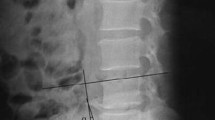Abstract
Objective
To observe the clinical efficacy of balance-impact tuina therapy for lumbar intervertebral disc herniation (LIDH).
Methods
A total of 118 eligible LIDH patients were randomized into an observation group and a control group by the random number table method, with 59 cases in each group. The observation group was intervened by balance-impact tuina therapy, while the control group was intervened by conventional tuina therapy, both for consecutive two weeks. The scores of visual analog scale (VAS), Oswestry disability index (ODI), quality of life questionnaire-core 30 (QOL-C30) were observed before and after treatment; the relapse rate was estimated at the sixth month and twelfth month following the treatment. The data were statistically analyzed.
Results
After intervention, the total effective rate was 96.6% in the observation group versus 91.5% in the control group, and the between-group difference was statistically significant (P<0.05). The VAS and ODI scores declined significantly after treatment in both groups (all P<0.05), and the observation group was markedly lower than the control group (P<0.05, P<0.01). The QOL-C30 score increased significantly after treatment in both groups (both P<0.05), and the observation group was markedly higher than the control group (P<0.05). The relapse rates at the post-treatment sixth month and twelfth month in the observation group were lower than those in the control group (P<0.05, P<0.01).
Conclusion
Compared with the conventional tuina therapy, the balance-impact tuina therapy shows advantage in lessening pain, improving the function and enhancing the quality of life in the treatment of LIDH, and it has a lower relapse rate. Thus, this therapy is worth promoting in clinic.
概要
目的
观察平衡冲击推拿疗法对腰椎间盘突出症(LIDH)的临床疗效。
方法
将符合纳入标准的118例LIDH患者按随机数字表法随机分为观察组和对照组, 每组59例。 观察组采用平衡冲击推拿疗法, 对照组采用传统推拿疗法, 两组均连续治疗2周。 观察治疗前后视觉模拟量表(VAS)评分、 Oswestry功能障碍指数(ODI)评分、 生活质量核心量表(QOL-C30)评分及治疗结束后第6个月、 第12个月复发率, 并进行统计分析。
结果
治疗后, 观察组总有效率96.6%, 对照组总有效率为91.5%, 两组比较有显著差异(P<0.05)。 治疗后, 两组VAS评分和ODI评分均较治疗前明显降低(均P<0.05), 且观察组明显低于对照组(P<0.05, P<0.01)。 治疗后, 两组QOL评分均较治疗前明显升高 (均P<0.05), 且观察组明显高于对照组(P<0.05)。 治疗后第6个月及第12个月随访复发情况, 观察组复发率均低于对照组(P<0.05, P<0.01)。
结论
平衡冲击推拿疗法治疗LIDH在缓解疼痛、 改善功能障碍、 提高生活质量方面优于传统推拿疗法, 且复发率低, 值得临床推广应用。
Similar content being viewed by others
References
Tian YX, Zhao JX, Wang YL, Xu L. Optimized design of several key aspects of the prospective cohort study about electroacupuncture combined with infrared treatment of lumbar disc herniation. Zhonghua Zhongyiyao Zazhi, 2018, 33(6): 2602–2604.
Liao B, He JZ. The clinical effect of TCM and canalis sacralis injection on prolapse of lumbar intervertebral disc. Xibu Yixue, 2014, 26(8): 1043–1045.
Xu QP, Song DF, Zhu XF, Niu SL. Clinical curative effect of treating lumbar disc herniation by herbal oral administration. Zhonghua Zhongyiyao Xuekan, 2018, 36(3): 765–768.
Li YL, Hu ZY, Lian JL, Peng H. Discussion of the relation between the compliance to the admission guidance for lumbar intervertebral disc herniation and the recurrence rate. Hunan Zhongyi Zazhi, 2015, 31(8): 127–128.
Xu SD, Ge BF, Xu YK. Practical Orthopedics. Beijing: People’s Military Medical Press, 2012: 2051–2054.
State Administration of Traditional Chinese Medicine. Criteria of Diagnosis and Therapeutic Effects of Diseases and Syndromes in Traditional Chinese Medicine. Nanjing: Nanjing University Press, 1994: 2.
Ministry of Health of the People’s Republic of China. Guiding Principles for Clinical Study of New Chinese Medicines. Beijing: China Medico-Pharmaceutical Science & Technology Publishing House, 2002: 3.
Wu YC, Sun YJ, Zhang JF, Li Y, Wang CM. Clinical research of mild and moderate lumbar disc herniation of blood stagnation syndrome treated with qi conducting needling technique at the governor vessel acupoints combined with electroacupuncture. Zhongguo Zhen Jiu, 2017, 37(5): 467–472.
Mu JS, Ni CM. Diagnostic and treatment standards for common diseases: comprehension of the graded diagnostic and treatment in the rehabilitation of lumbar intervertebral disc herniation. Anhui Yixue, 2017, 38(5): 674–675.
Wang EJ, Zhang H. Study on the relationship between TCM syndrome types and pathology of Western medicine of lumbar disc herniation based on imaging. Xibu Zhongyiyao, 2017, 30(2): 131–133.
Wu XY, Ma DM, Ma HS. Forty-five cases of lumbar intervertebral disc herniation treated with Zhu Yu Zhi Tong formula plus bonesetting manipulations. Zhongyi Yanjiu, 2018, 31(8): 23–26.
Wei LS, Xie B, Zhang XY. General status of non-surgery methods in the treatment of lumbar intervertebral disc herniation. Hunan Zhongyi Zazhi, 2018, 34(6): 182–183, 191.
Song NC, Ouyang LM, He Y, Jiang Jue, Xu HB. Thirty cases of lumbar intervertebral disc herniation treated with acupuncture-moxibustion. Zhongguo Zhen Jiu, 2008, 28(S1): 105–106.
Zhang LF, Mao XJ, Wang WJ. Balance acupuncturemoxibustion in the treatment of 160 cases of lumbar intervertebral disc herniation. Zhongguo Zhen Jiu, 2008, 28(8): 596.
He XW, Huang JH, Zeng LY. Observation on the therapeutic effect of warming needle moxibustion on prolapse of lumbar intervertevral disc. Zhongguo Zhen Jiu, 2007, 27(12): 264–266.
Liang JZ, You L. Sixty cases of lumbar intervertebral disc herniation coupled with sciatica treated with acupuncturemoxibustion. Zhongguo Zhen Jiu, 2005, 25(S1): 93.
Bai Y, Pan FW. Analysis of treatment of lumbar intervertebral disc herniation based on the theory of interoperability between tendon and bone in Pingle bonesetting therapy. Zhongguo Zhongyi Gushangke Zazhi, 2018, 26(6): 80–81, 84.
Feng YT. Integrated Traditional Chinese and Western Medicine for Soft Tissue Injuries. Beijing: People’s Medical Publishing House, 1997: 71–73.
Fan ZY, Wu S, Li ZB, Lai SH, Guo RS, Tian Q. Reflections on lifting-pulling-rotating and oblique-pulling manipulation in treating lumbar interverbral disc herniation based on the equilibrium of bone biomechanic. Zhongguo Zhongyi Jizheng, 2016, 25(4): 642–643, 681.
Acknowledgments
This work was supported by Clinical Medical Technological Innovation and Guiding Program, Hunan Provincial Technological Innovation and Guiding Plan (湖 南省技术创新引导计划-临床医疗技术创新引导项目, No. 2017SK51108, No. 2017SK51110); Science and Technology Plan Program of Chenzhou 2017 (郴州市2017 年科技计划项目, No. jsyf2017036).
Author information
Authors and Affiliations
Corresponding authors
Rights and permissions
About this article
Cite this article
Zhang, Zq., Liu, X., Zhong, H. et al. Therapeutic observation of tuina manipulation for lumbar intervertebral disc herniation. J. Acupunct. Tuina. Sci. 17, 116–123 (2019). https://doi.org/10.1007/s11726-019-1101-3
Received:
Accepted:
Published:
Issue Date:
DOI: https://doi.org/10.1007/s11726-019-1101-3
Keywords
- Tuina
- Massage
- Low Back Pain
- Intervertebral Disc Displacement
- Pain Measurement
- Visual Analog Scale
- Quality of Life



